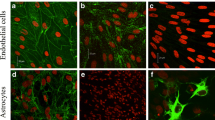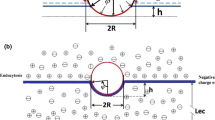Abstract
We have measured the permeability and binding characteristics of bovine serum albumin (BSA), cationized BSA (cBSA), and glycosylated BSA (gBSA) to primary cultures of bovine brain capillary endothelial cells (BBCEC). These endothelial cells serve as an in vitro model to study the binding, uptake, and transcellular transport of small and large molecule flux across the blood–brain barrier. The rate of [3H]BSA flux across the cultured BBCEC monolayers grown onto polycarbonate membranes (5-µm pore size) was linear with increasing BSA concentration and the flux could be inhibited by temperature reduction to 0–4°C. The maximal binding of [3H]BSA was 0.04 fmol/mg total cell protein and could not be inhibited by nonradiolabeled BSA. The binding of cBSA and gBSA was rapid and could be inhibited by nonradiolabeled cBSA or gBSA, respectively. The maximal amount bound was 1.8 fmol/mg total cell protein for cBSA and 17.4 fmol/mg total cell protein for gBSA. The dissociation constants (K d's) were 27 ± 13 and 3.7 ± 1.1 nM for cBSA and gBSA, respectively. The flux rates of cBSA and gBSA across the endothelial cell monolayers were linear with respect to concentration and they were approximately seven times greater than those observed for BSA. Each of the proteins appeared on the antiluminal side of the endothelial cell monolayers primarily (90%) as intact protein as determined by trichloroacetic acid (TCA) precipitations and sodium dodecyl sulfate (SDS)–polyacrylamide gel electrophoresis (PAGE). The results for BSA are similar to those observed for lucifer yellow, a fluid-phase endocytic marker. In contrast to BSA, the binding and transcellular transport of cBSA and gBSA appear to proceed by an adsorptive-phase endocytic mechanism.
Similar content being viewed by others
REFERENCES
W. M. Pardridge. Endocrine Rev. 7:314–330 (1986).
J. B. Long and J. W. Holaday. Science 227:1580–1583 (1985).
S. K. Williams, J. J. Devenny, and M. W. Bitensky. Proc. Natl. Acad. Sci. USA 78:2393–2397 (1981).
H. Vlassara, M. Brownlee, and A. Cerami. Clin. Chem. 32:B37–B41 (1986).
M. Brownlee, H. Vlassara, and A. Cerami. Ann. Intern. Med. 101:527–537 (1984).
A. K. Kumagai, J. Eisenberg, and W. M. Pardridge. J. Biol. Chem. 262:15214–15219 (1987).
D. E. Griffin and J. Giffels. J. Clin. Invest. 70:289–295 (1982).
K. L. Audus and R. T. Borchardt. Pharm. Res. 3:81–87 (1986).
U. K. Laemmli. Nature 227:680 (1970).
W. M. Pardridge, J. Eisenberg, and W. T. Cefalu. Am. J. Physiol. 249:E264–E267 (1985).
A. Baranczyk-Kuzma, K. L. Audus, and R. T. Borchardt. J. Neurochem. 46:1956–1960 (1986).
R. C. Speth and S. I. Haricks. Proc. Natl. Acad. Sci. USA 82:6340–6343 (1985).
P. J. Jacques. In B. F. Trump and A. V. Arstila (eds.), Pathobiology of Cell Membranes, Academic Press, New York, 1975, pp. 255–282.
S. K. Williams. N.Y. Acad. Sci. 416:457–467 (1983).
J. A. Swanson, B. D. Yirinec, and S. C. Silverstein. J. Cell Biol. 100:851–859 (1985).
J. A. Cooper, P. J. Del Vecchio, F. L. Minnear, K. E. Burhop, W. M. Selig, J. G. N. Garcia, and A. B. Malik. J. Appl. Physiol. 63:1076–1083 (1987).
E. M. Renkin. Acta Physiol. Scand. Suppl. 463:81–91 (1979).
V. A. Levin. J. Med. Chem. 23:682–684 (1980).
F. L. Guillot, T. J. Raub, and K. L. Audus. J. Cell Biol. 105:312 (1987).
A. Muckerheide, R. J. Apple, A. J. Pesce, and J. G. Michael. J. Immunol. 138:833–837 (1987).
N. Shaklai, R. L. Garlick, and H. F. Bunn. J. Biol. Chem. 259:3812–3817 (1984).
J. L. Carpentier, P. Gorden, A. Robert, and L. Orci. Experientia 42:734–744 (1986).
K. S. Matlin. J. Cell Biol. 103:2565–2568 (1986).
B. R. Lentz, Y. Barenholz, and T. E. Thompson. Biochemistry 15:4521–4528 (1976).
B. R. Lentz, Y. Barenholz, and T. E. Thompson. Biochemistry 15:4529–4537 (1976).
J. D. Fenstermacher. Trends Neurosci. 8:449–453 (1985).
Author information
Authors and Affiliations
Rights and permissions
About this article
Cite this article
Smith, K.R., Borchardt, R.T. Permeability and Mechanism of Albumin, Cationized Albumin, and Glycosylated Albumin Transcellular Transport Across Monolayers of Cultured Bovine Brain Capillary Endothelial Cells. Pharm Res 6, 466–473 (1989). https://doi.org/10.1023/A:1015960205409
Issue Date:
DOI: https://doi.org/10.1023/A:1015960205409




